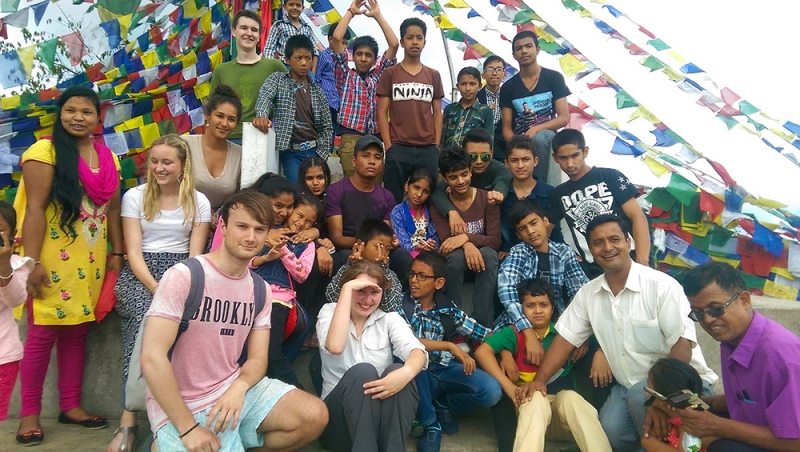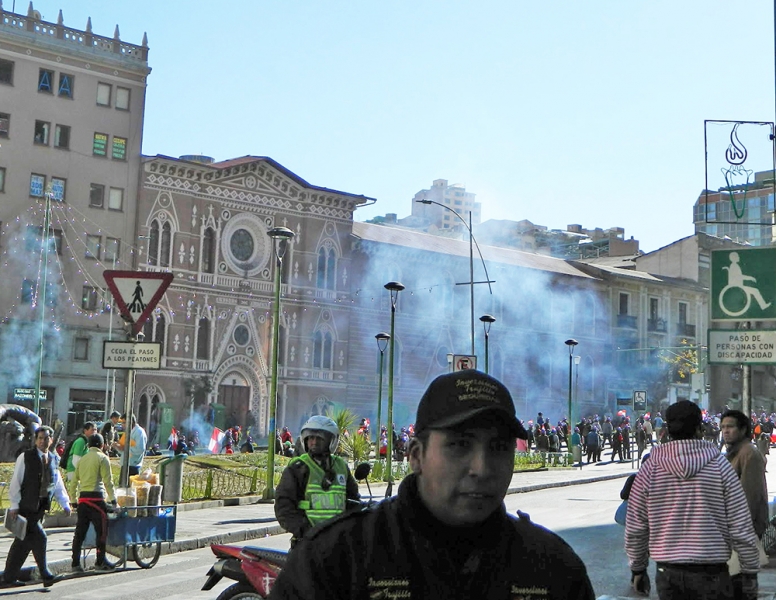Making the most of the holidays: the adventures of two St John’s undergraduates
With the end of the Michaelmas Term and the beginning of the Christmas break upon us, this is a story about two Johnian undergraduates who made the most of their time off by embarking on eye-opening adventures abroad, partly funded by the College’s Travel Grants Scheme. A longer version of this article first appeared in the College newsletter Eagle Eye.
Teaching children in Kathmandu, Nepal, after the earthquake and a Bolivian journalism internship in the midst of political unrest were the projects undertaken by two St John’s undergraduates, Harriet Baldwin and Hannah Mills, during their Long Vacation, partly funded by the College’s Travel Grants scheme.
Every year St John’s offers a range of Exhibitions and Grants for the promotion of travel during the Long Vacation. This year, from across 16 available funds, 65 students received awards of between £80 and £1,200 to support their summer projects. Different grants are on offer for projects ranging from visits to archaeological sites in Europe and adventurous travel in remote parts of the world, to working in Africa or carrying out field work in Earth Sciences. We spoke to Harriet and Hannah about their experiences, and the opportunities a travel grant can provide.
Third-year Historian Harriet Baldwin spent seven weeks teaching English to 9-13 year-olds at the Hindu-Vidyapeeth School in Kathmandu. A £300 Christopher Vincent Travel Grant covered Harriet’s injections and the cost of living in Nepal, which was relatively low as the school provided accommodation and meals as well as opportunities to travel beyond Kathmandu.
Harriet wasn’t sure what to expect before she went. “I had been to Malaysia on a school World Challenge, but Nepal is much less developed, and because of the earthquake in April I thought there might be a lot of devastation.” She was pleased to discover that life in Kathmandu had regained a semblance of normality. “Nothing really runs smoothly there,” she admitted, “but I don’t think it did before the earthquake!”
The biggest challenge Harriet faced was the job itself. Having only tutored individuals, facing a class of 20 children with limited English was a nerve-wracking experience, and it took Harriet a few days to get into the swing of things.
Despite the steep learning curve, Harriet said she would definitely recommend the experience. “The amazing thing about this scheme is how much it benefits the children. They really need English people to go and teach, so they learn the right things and not just what the Nepalese think English is like.”

Third-year English student Hannah Mills completed a journalism internship at Bolivian Express, a magazine for English speakers living in Bolivia. As part of a structured programme, interns receive Spanish tuition as well as training in journalism and photography.
The downside was the cost – £800 for the placement and £1000 for flights – but a £600 Johnian Society Travel Exhibition enabled Hannah to cover the rest using money she has saved from working in the holidays at a financial services company in London.
During the four week placement Hannah wrote two articles – one on the Bolivian concrete poet Paola Senseve and another on the Plaza as a symbolic space. The biggest challenge was the language. “I did GCSE Spanish and have kept it up, but it’s a big jump from that to interviewing poets,” she explained. “I had to work hard to get up to speed with the vocabulary I needed.”
She also found herself in the midst of political unrest, after unknowingly walking into a riot in the course of researching her article on the Plaza de La Paz. “It was supposed to be about the Plaza as a symbol of freedom, but we arrived in the middle of a protest by Potosi miners. Afterwards I had to change my plan. The article ended up being about the politics of the place.”

For Hannah, interviewing and meeting so many new people was the best aspect of the internship. She added that cycling the so-called ‘Death Road’, a 56-kilometre stretch between La Paz and Coroico known as world’s most dangerous road, was “the most amazing thing I’ve ever done”.
Hannah said the internship has helped her to see what kind of journalism she really wants to do. “Actually, it’s probably not this type. This was social commentary, written for a limited audience. I’m interested in writing to change something.”
A full list of the travel awards offered to current members is available on the website at http://www.joh.cam.ac.uk/travel-grants.
The full version of this article, and many more stories about College life, news and highlights, can be read in Eagle Eye - the newsletter for Fellows, staff and students at St John’s. Read it online via: http://www.joh.cam.ac.uk/eagle-eye-michaelmas-term-2015 or pick up a copy around College.